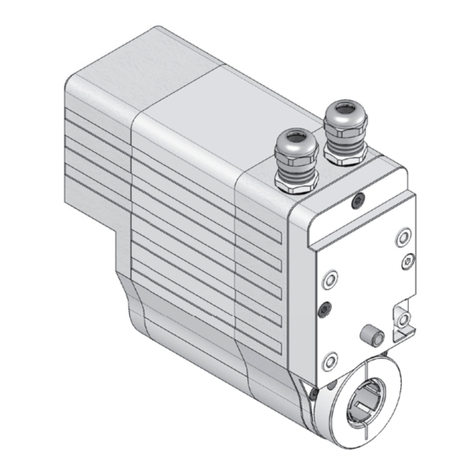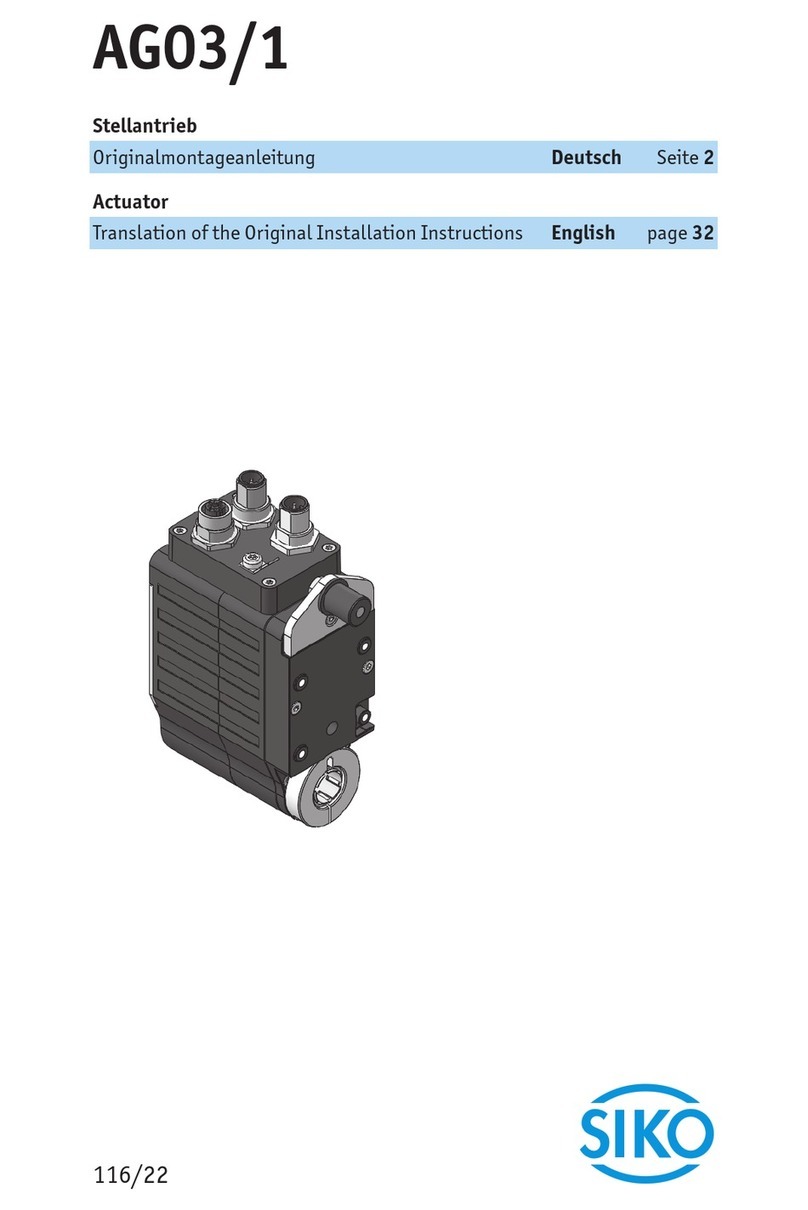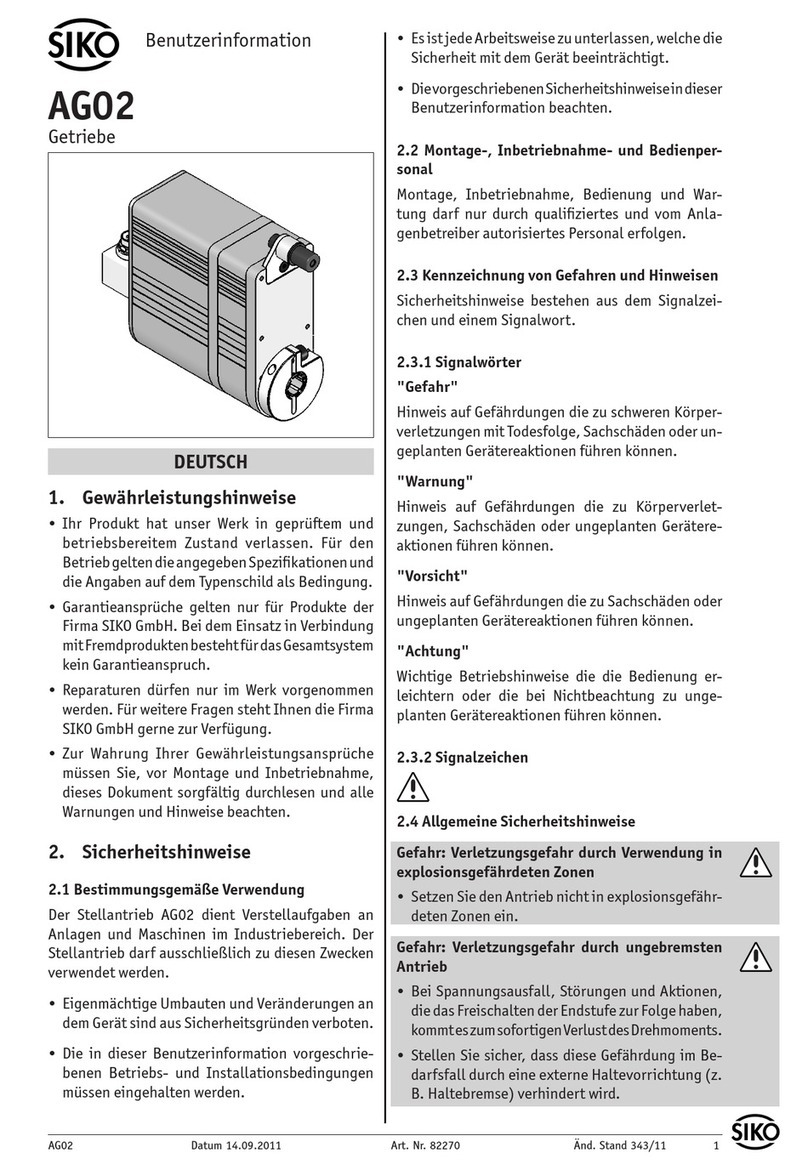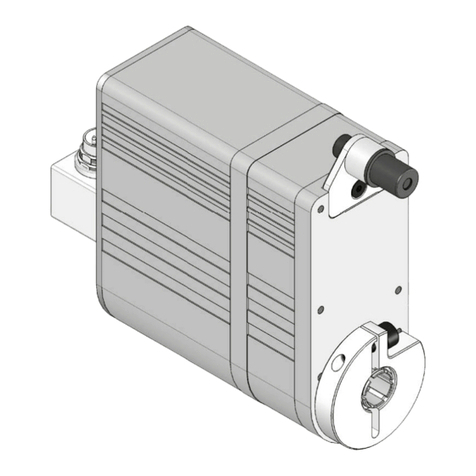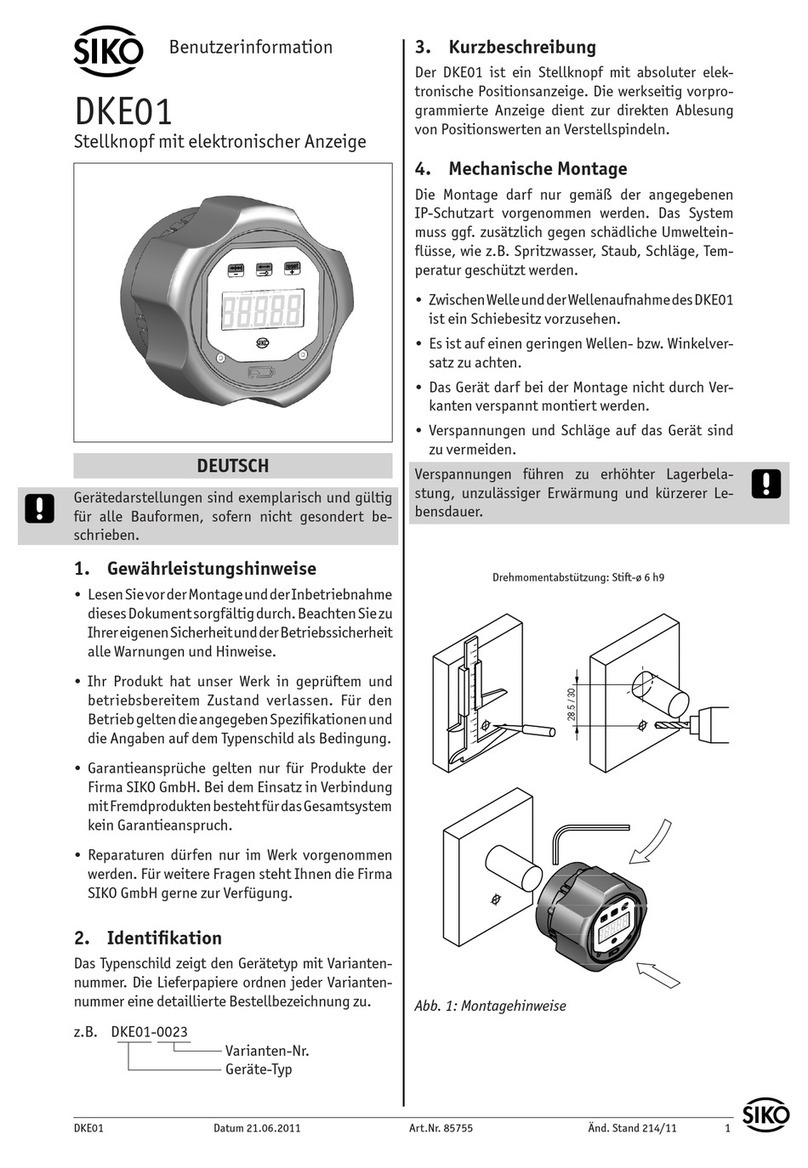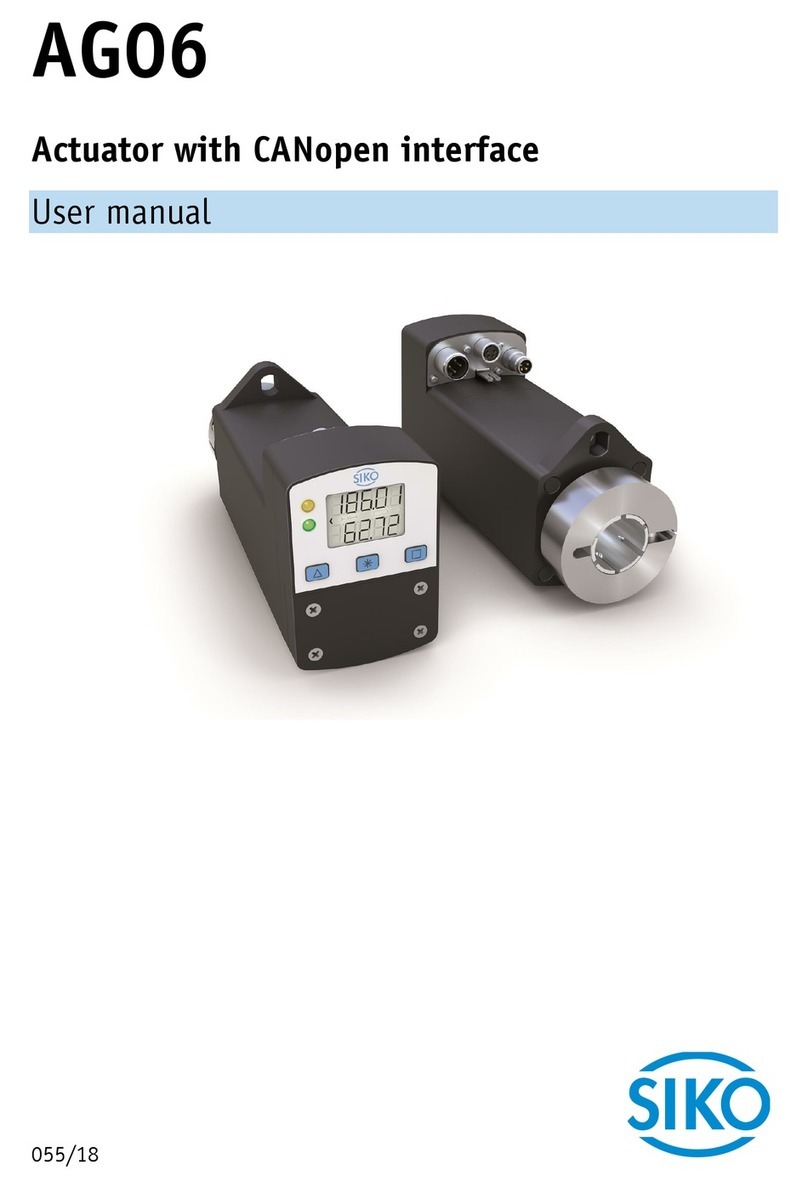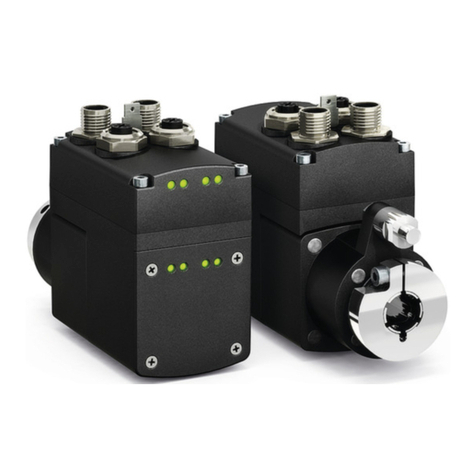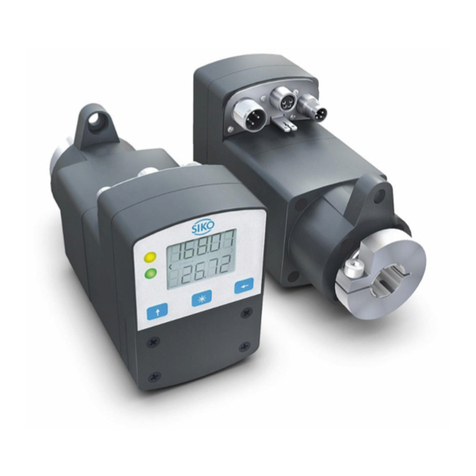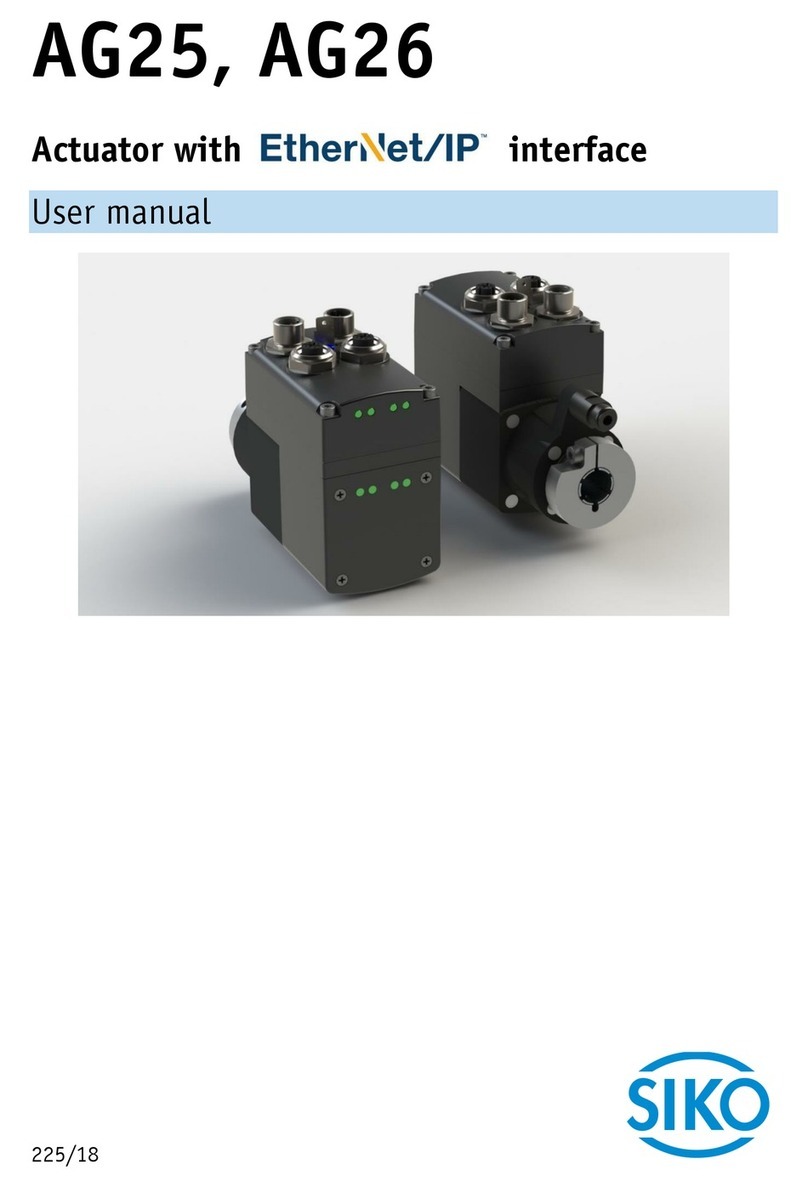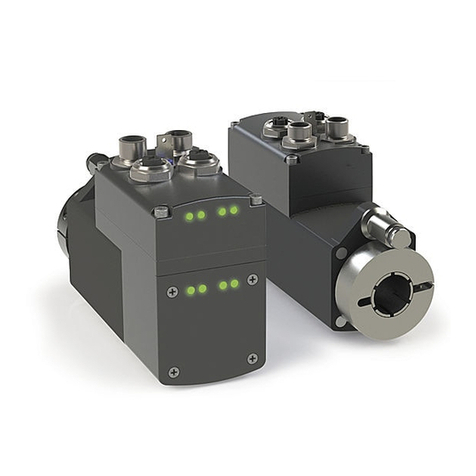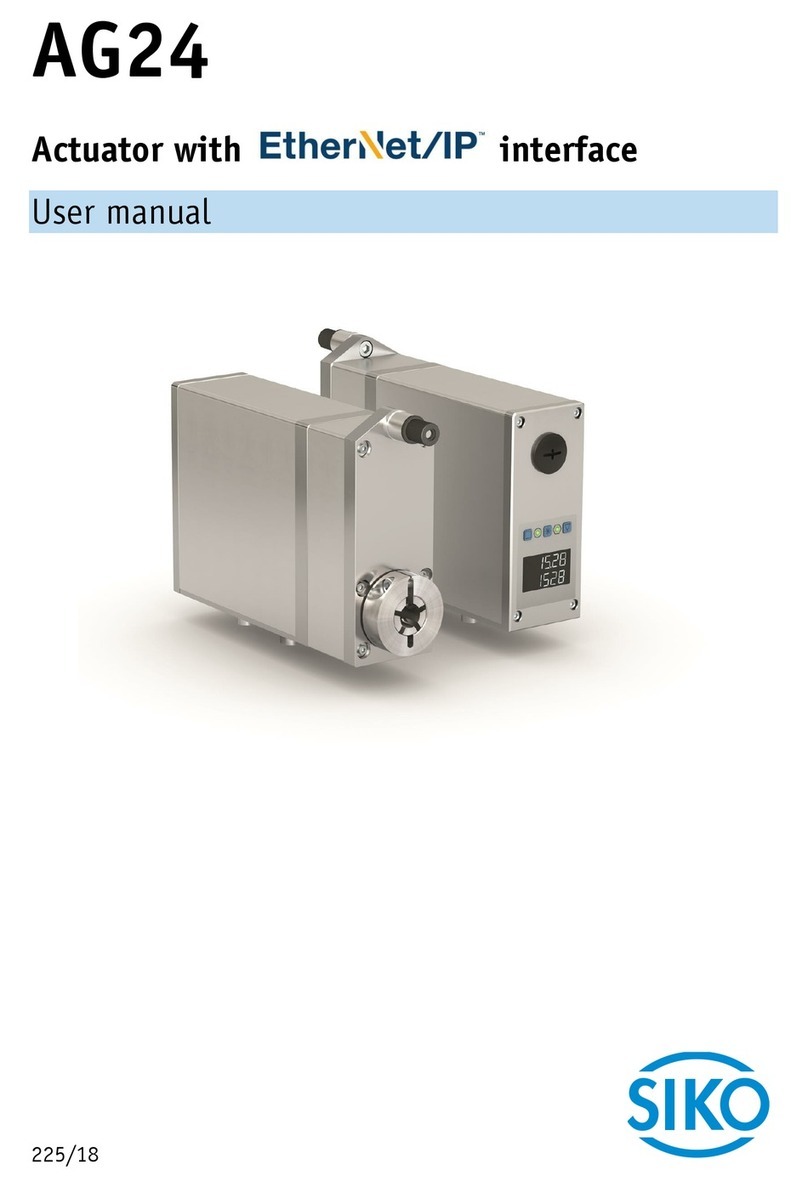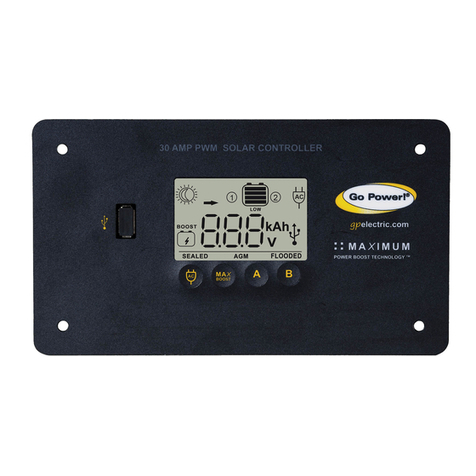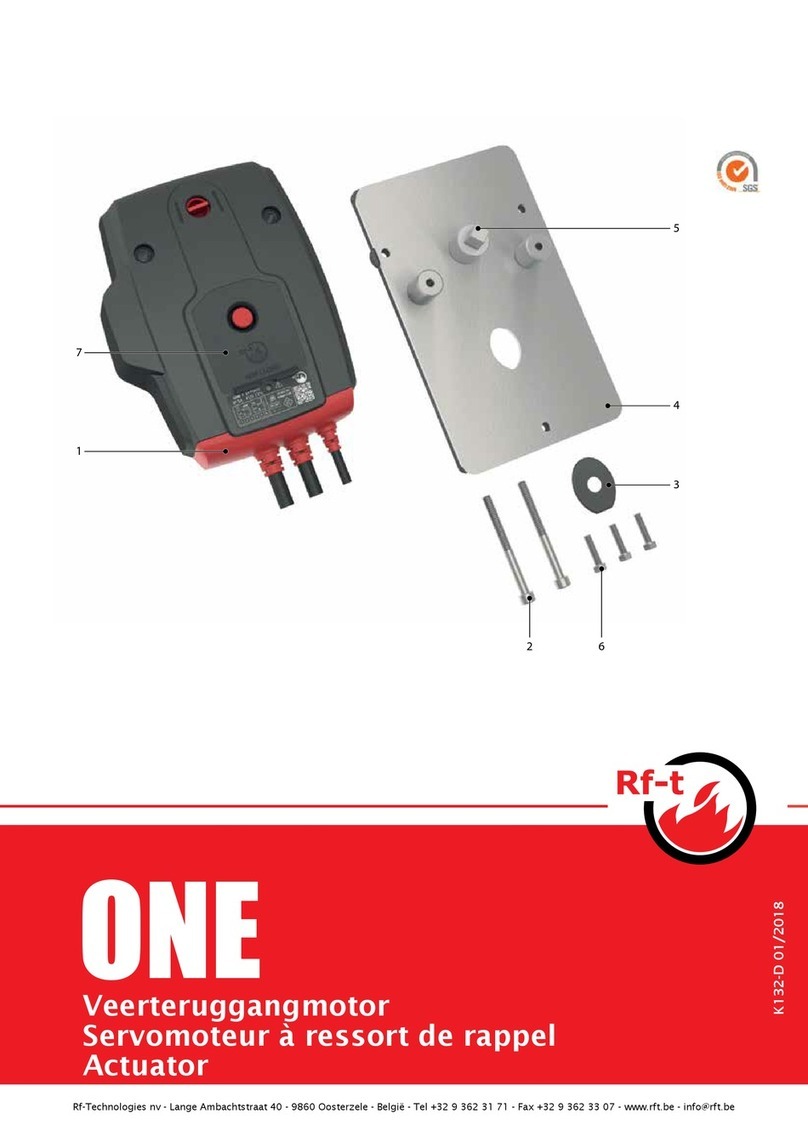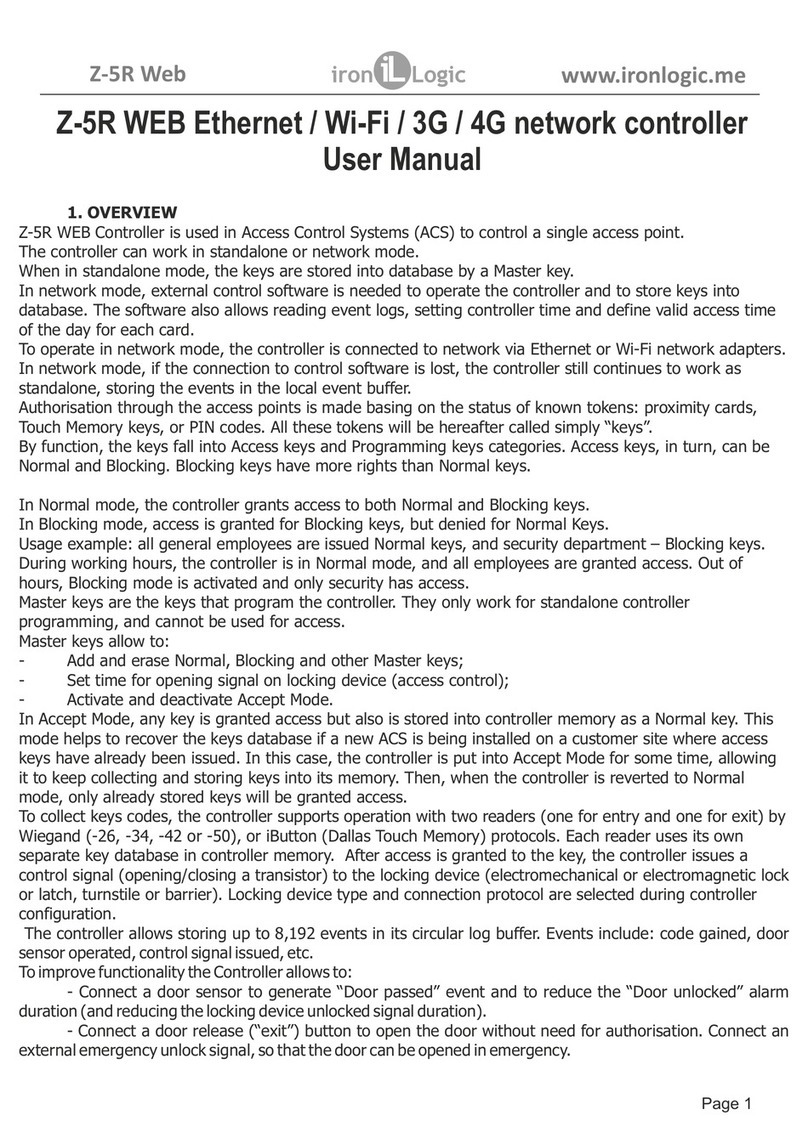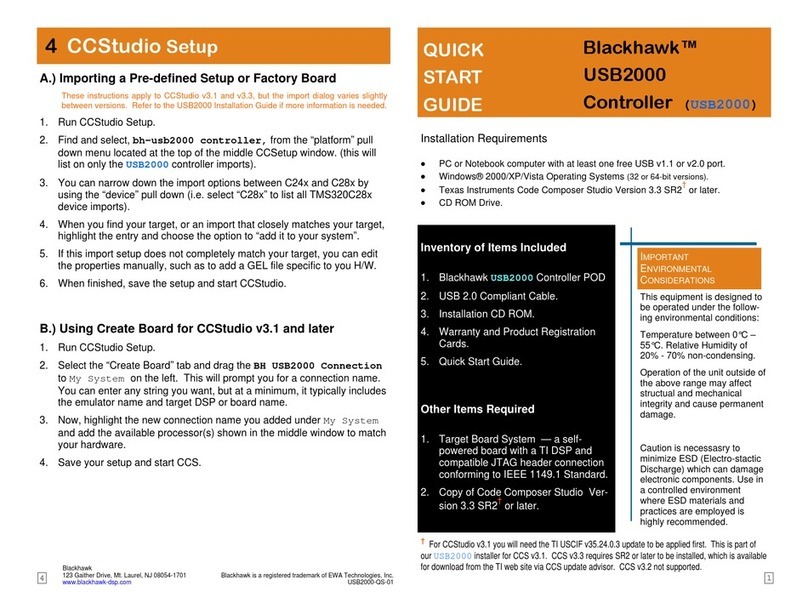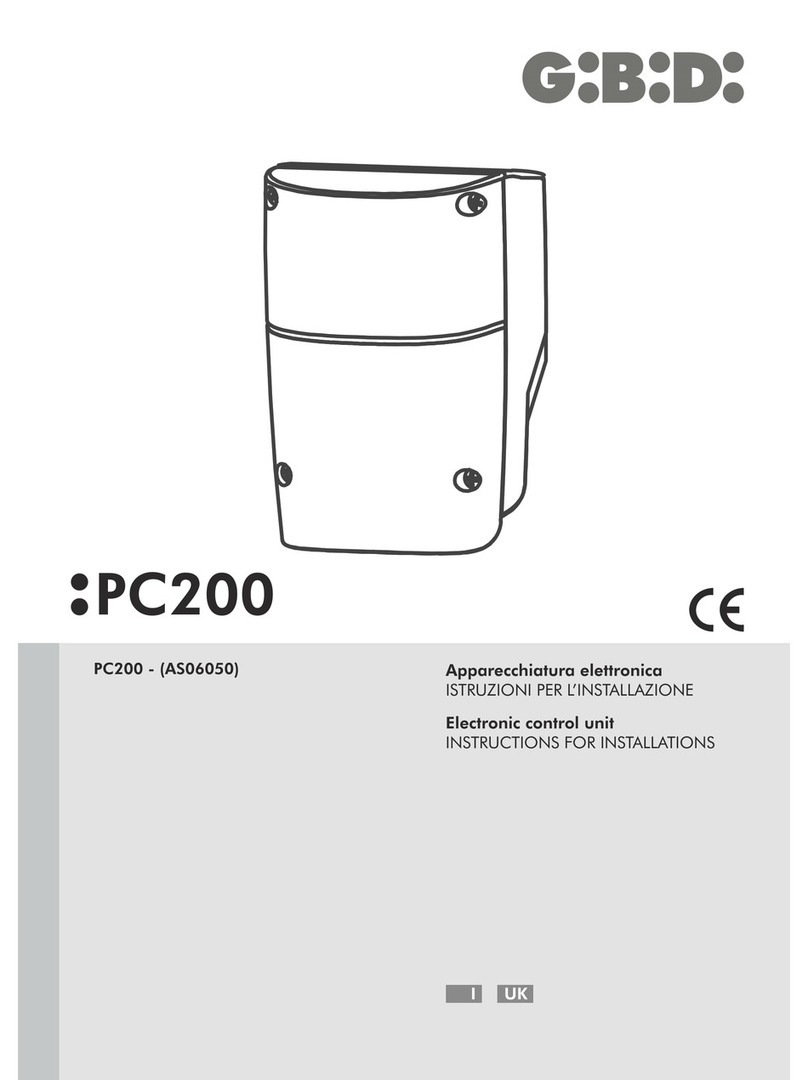Siko MSA501 User manual

330/18
MSA501
Actuator with CANopen interface
User manual

MSA501 Date: 12.10.2018 Art. No. 88734 Mod. status 330/18 Page 2 of 51
Table of contents
1General Information .................................................................................................. 4
1.1 Documentation ........................................................................................................4
1.2 Definitions ..............................................................................................................4
2Intended use............................................................................................................. 4
2.1 Switching on the supply voltage.................................................................................4
3Operating elements ................................................................................................... 5
3.1 General Information..................................................................................................5
3.2 LEDs .......................................................................................................................5
3.3 DIP switch (applies only to SP01 + SP03).....................................................................7
4Functional description ............................................................................................... 8
4.1 Measuring range.......................................................................................................8
4.2 Calibration ..............................................................................................................9
4.3 Reset to factory settings .........................................................................................10
5Communication via CAN bus (CANopen) .................................................................... 10
5.1 Telegram structure..................................................................................................10
5.2 Node control..........................................................................................................12
5.2.1 Network management (NMT) services .....................................................................12
5.2.1.1 NMT communication states ...............................................................................12
5.2.1.2 Toggling between the NMT communication states ................................................13
5.2.2 Boot-Up.............................................................................................................13
5.2.3 SYNC object........................................................................................................13
5.3 Process data exchange ............................................................................................14
5.3.1 Transfer of process data objects (PDO) ...................................................................14
5.3.1.1 Transmit PDO (from the MSA501 to the master) ...................................................14
5.3.1.2 Variable TPDO mapping.....................................................................................15
5.4 Parameter data exchange.........................................................................................16
5.4.1 Transmission of Service Data Objects (SDO).............................................................16
5.4.1.1 Expedited Request/Response .............................................................................16
5.4.1.2 Normal Request/Response.................................................................................18
5.4.1.3 Error Response in SDO exchange ........................................................................19
5.4.1.4 SDO examples .................................................................................................20
5.5 Node monitoring ....................................................................................................21
5.5.1 Emergency Service (EMCY) ....................................................................................21
5.5.2 Node Guarding....................................................................................................22
5.5.3 Heartbeat ..........................................................................................................23
5.6 Directory of objects ................................................................................................24
5.6.1 Overview of objects .............................................................................................24
5.6.2 Object description...............................................................................................25
5.6.2.1 1000h: Device Type..........................................................................................25
5.6.2.2 1001h: Error Register .......................................................................................26

MSA501 Date: 12.10.2018 Art. No. 88734 Mod. status 330/18 Page 3 of 51
5.6.2.3 1002h: Manufacturer Status Register ..................................................................26
5.6.2.4 1003h: Pre-defined Error Field...........................................................................27
5.6.2.5 1005h: COB-ID SYNC-Nachricht ..........................................................................27
5.6.2.6 1008h: Manufacturer Device Name .....................................................................28
5.6.2.7 1009h: Manufacturer Hardware Version ...............................................................28
5.6.2.8 100Ah: Manufacturer Software Version................................................................28
5.6.2.9 100Ch: Guard Time...........................................................................................29
5.6.2.10 100Dh: Life Time Factor....................................................................................29
5.6.2.11 1010h: Store Parameter....................................................................................29
5.6.2.12 1011h: Restore Parameter.................................................................................32
5.6.2.13 1014h: COB-ID Emergency-Nachricht ..................................................................34
5.6.2.14 1015h: Inhibit time EMCY .................................................................................34
5.6.2.15 1017h: Producer Heartbeat Time........................................................................35
5.6.2.16 1018h: Identity Objekt.....................................................................................35
5.6.2.17 1200h: Server SDO Parameter ............................................................................36
5.6.2.18 1800h: 1. Transmit PDO Parameter .....................................................................37
5.6.2.19 1801h: 2nd Transmit PDO Parameter...................................................................38
5.6.2.20 1A00h: 1. Transmit PDO Mapping Parameter ........................................................40
5.6.2.21 1A01h: 2. Transmit PDO Mapping Parameter ........................................................40
5.6.2.22 5115h: Calibrate encoder value..........................................................................41
5.6.2.23 5116h: Set the boundary ..................................................................................42
5.6.2.24 5122h: Register...............................................................................................42
5.6.2.25 5F09h: Bus terminator (not available with SP01 + SP03) .......................................44
5.6.2.26 5F0Ah: Node-ID and baud rate Bus CAN ..............................................................44
5.6.2.27 6000h: Operating Parameters ............................................................................45
5.6.2.28 6003h: Preset value (Calibration value) ..............................................................46
5.6.2.29 6004h: Position value ......................................................................................46
5.6.2.30 6005h: Resolution and velocity step width..........................................................46
5.6.2.31 6030h: Velocity value.......................................................................................47
5.6.2.32 6200h: Zyklus Timer.........................................................................................48
5.6.2.33 6500h: Operating Status...................................................................................48
5.6.2.34 6501h: Measuring step .....................................................................................48
5.6.2.35 6502h: Number of distinguishable revolutions .....................................................49
5.6.2.36 6507h: Profile and Software Version...................................................................49
5.6.2.37 6508h: Operating Time.....................................................................................49
5.6.2.38 6509h: Offset value .........................................................................................50
5.6.2.39 650Ah: Module Identification............................................................................50
5.6.2.40 650Bh: Serial number.......................................................................................51

General Information
MSA501 Date: 12.10.2018 Art. No. 88734 Mod. status 330/18 Page 4 of 51
1General Information
1.1 Documentation
The following documents are associated with this product:
Data sheet; it describes the technical data, the dimensions, the pin assignment, the
accessories and the order key.
Mounting instructions; they describe the mechanical and electrical installation with all
safety-relevant conditions and the associated technical specifications.
User manual; for commissioning the sensor and integrating it into a fieldbus system.
EDS file (electronic data sheet); this file enables integration and configuration in a
CANopen network by means of commercial CANopen configurators.
These documents can also be found at http://www.siko-global.com/p/msa501
1.2 Definitions
Decimal values are given as numbers without addition (e.g. 1234), except when indicated in
direct connection with binary or hexadecimal values in which case the extension d will be
used (e.g. 1234d). Binary values are identified by adding b (e.g. 1011b) to the figures
whereas hexadecimal values are extended by h (e.g. 280h).
2Intended use
The sensor collects the distance information of the coded MBA501 magnetic tape. By means
of the CANopen protocol, the sensor can be configured and read out via the CAN interface. For
instance, a superordinate control unit can read the absolute position value with a resolution
of 10 μm (or 5 μm, resp.).
On the upper side of the sensor there are 3 LEDs (yellow, red, green), which indicate error or
status information for diagnostic purposes.
If the sensor is lifted from the tape, an error will be detected and 0 will be output as the
position value and the yellow LED will flash 1x.
2.1 Switching on the supply voltage
MSA501 initializes after being switched on. During initialization, the LEDs light up one after
the other and the configuration parameters are loaded from the non-volatile memory to the
random memory of the controller.

Operating elements
MSA501 Date: 12.10.2018 Art. No. 88734 Mod. status 330/18 Page 5 of 51
The sensor will work with its default values as long as no changes have been made to it. With
parameters changed, the sensor will work with the changed data, which must be stored if they
are intended to be used after power off/on.
After completing the initialization procedure, the sensor sends a specific NMT command, the
boot-up message, which informs the system about the availability of the sensor. The MSA501
is now in the pre-operational mode. In this state, the sensor can be parameterized via SDO
commands in accordance with the requirements of the application. This applies to the
configuration parameters of the sensor unit as well as to the way it makes available to the
system its position values (asynchronous or synchronous data transmission).
3Operating elements
3.1 General Information
In its standard version, the sensor has a bus terminator, which can be energized via an SDO
object (see chapter 5.6.2.25 5F09h: Bus terminator (not available with SP01 + SP03)). The
SP01 +SP03 variant features an 8-pole DIP switch, which enables the adjustment of bus
terminator, node ID and baud rate. The sensor has 3 LEDs with yellow, green and red colors.
Fig. 1: Operating elements
3.2 LEDs
The device has 3 LEDs for diagnostic and status purposes,
A yellow LED for device-specific states
A green LED indicating the NMT status (CAN Run LED)
A red LED for CAN error states (CAN Err LED)

Operating elements
MSA501 Date: 12.10.2018 Art. No. 88734 Mod. status 330/18 Page 6 of 51
Device-specific diagnosis
The yellow LED is lit while the device is operating. It starts flashing when an error occurs. The
error states are differentiated by the number of LED flashes. The signal is repeated after a
pause of 600 ms. If multiple error states occur simultaneously, then the individual flash
signals add to form a sequence (e.g. yellow LED flashes 5x -> Sensor/tape reading distance
error state + velocity check).
Error state
Number of
flashes
Sensor/tape reading distance
1x
Plausibility of absolute value
2x
Velocity check (v > 5 m/s)
4x
Sensor-tape alignment
8x
Table 1: device-specific status LED
CAN diagnosis:
The CiA DS-303 Part 3 V1.4.0 indicator specification is the basis of the CAN diagnosis
LED state
Description
On
LED is permanently on
Off
LED is permanently off
Blinking
LED flashes at a frequency of 2.5 Hz (200 ms on/off)
Single Flash
LED is 200 ms on, 1000 ms off
Double Flash
LED is 200 ms on, 200 ms off, 200 ms on, 1000 ms off
Table 2: CAN LED statuses acc. to CiA DS-303
CAN Run LED:
NMT state
LED state
Pre-Operational
Flashing
Operational
On
Stopped
Single Flash
Table 3: CAN Run LED
CAN Err LED:
Error states
LED state
No error
Off
Warning limit reached (at least one error counter (Transmit Error
Counter CANTEC or Receive Error Counter CANREC) of the CAN
controller has reached or exceeded the warning limit (too many No
Error frames).
Single Flash
Error control event
=> A Guard Event (if no RTR Node guard received from master
within the lifetime set)
Double Flash

Operating elements
MSA501 Date: 12.10.2018 Art. No. 88734 Mod. status 330/18 Page 7 of 51
Error states
LED state
Bus off
On
Table 4: CAN Err LED
3.3 DIP switch (applies only to SP01 + SP03)
The device has an 8-pole DIP switch, which enables a bus resistor to be energized and the bus
node ID and baud rate to be configured. If the DIP switches are at the position “Use from
memory”, then the node ID and baud rate can be changed per CAN bus via object 5F0Ah:
Node-ID and baud rate Bus CAN. The switch position is scanned once during the startup
process. The adoption of a node ID or baud rate bus reset later occurs only after re-
initialization (see chapter 5.2.1 Network management (NMT) services).
Switch no.
1
2
3
4
5
6
7
8
Meaning
Bus baud rate
Node-ID (address)
Bus termination
Table 5: DIP switch
DIP switch
Bus baud rate
1
2
3
0
0
0
Use baud rate from memory
0
0
1
50k kBaud
0
1
0
100 kBaud
0
1
1
125 kBaud
1
0
0
250 kBaud
1
0
1
500 kBaud
1
1
0
1M Baud
1
1
1
Use baud rate from memory
Table 6: DIP switch for bus baud rate
DIP switches
Node-ID (Address)
4
5
6
7
0d
0d
0d
0d
Use address from memory
0d
0d
0d
1d
1d (1h)
0d
0d
1d
0d
2d (2h)
0d
0d
1d
1d
3d (3h)
0d
1d
0d
0d
4d (4h)
0d
1d
0d
1d
5d (5h)
0d
1d
1d
0d
6d (6h)
0d
1d
1d
1d
7d (7h)
1d
0d
0d
0d
8d (8h)

Functional description
MSA501 Date: 12.10.2018 Art. No. 88734 Mod. status 330/18 Page 8 of 51
DIP switches
Node-ID (Address)
4
5
6
7
1d
0d
0d
1d
9d (9h)
1d
0d
1d
0d
10d (Ah)
1d
0d
1d
1d
11d (Bh)
1d
1d
0d
0d
12d (Ch)
1d
1d
0d
1d
13d (Dh)
1d
1d
1d
0d
14d (Eh)
1d
1d
1d
1d
15d (Fh)
Tabelle 7: DIP switches Node-ID
4Functional description
4.1 Measuring range
The numbers given below refer to an absolute resolution of 0.005 mm; divide the numerical
values into half for an absolute resolution of 0.01 mm!
Representation of numerical values:
The numerical value output by the MSA501 sensor via the interface is always a multiple of the
resolution set.
Example:
Value output by the sensor = 340603; set resolution = 0.005 mm
-> position value = 340603 * 0,005 mm = 1703,015 mm
With a resolution set to 0.01 mm, the above output value corresponds to a position value of
3406,030 mm.
Tape coding:
The absolute coding of MBA501 enables a maximum measuring range of 10240 mm
(=2048000 * 0,005 mm).
Fig. 2: Tape coding
Position value:
In order to avoid jumps around the maximum value at position 0, this maximum value is
limited to 10000 mm (=2000000 * 0,005 mm). Thus, a range up to -240 mm (= -48000 *
0.005 mm) is possible in negative travel direction
0
+1
+2047999
+2047999
+1
0

Functional description
MSA501 Date: 12.10.2018 Art. No. 88734 Mod. status 330/18 Page 9 of 51
Fig. 3: Position value
Variable boundary:
In case the measurement range is to be extended in negative direction, there exists the
possibility of programming a positive value as a boundary via interface,
e.g.: Boundary = 6000 mm (measurement range = -4240 mm ... +6000 mm;
-4240 mm / 0.005 mm = 848000; +6000 mm / 0.005 mm = +1200000)
Fig. 4: Variable boundary:
Counting direction:
The sensor delivers ascending numerical values when the sensor is moved in the plug outlet
direction. This feature can be changed via object 6000h: Operating Parameters (descending
numerical values when the sensor is moved in the plug outlet direction).
4.2 Calibration
The MSA501 features an absolute measurement system, i.e. the information of the position
value is represented in the scale (MBA501 magnetic tape) as an absolute value. Calibration
can be performed at any position on the magnetic tape.
Position value = measured value + calibration value
The measured value is set to zero when calibrating.
At the actual sensor position, the value “position value = 0 + calibration value” is output from
then on. With calibration, the actual position value is replaced by the set calibration value
and stored non-volatilely.
Two steps are required for executing calibration:
1. Write calibration value (see Object 6003h: Preset value (Calibration value))
2. Execute calibration (reset) (see object 5115h: Calibrate encoder value)
The following equation is applied in case of calibration:
Position value = 0 + calibration value
-480000
0
+1
-1
-1
+1
0
-480000
+1999999
-848000
0
+1
-1
-1
+1
0
-848000
+1199999

Communication via CAN bus (CANopen)
MSA501 Date: 12.10.2018 Art. No. 88734 Mod. status 330/18 Page 10 of 51
4.3 Reset to factory settings
To return to the original condition of the device as delivered, there exist the following
options:
Access
Coding
Settings are restored for
CANopen
(See object 1011h:
Restore Parameter)
1011h
"load"
Sub-index 1
All parameters
Sub-index 2
Only bus parameters
Sub-index 3
Only CiA DS-406 parameters
Sub-index 4
Only manufacturer-specific parameters
Table 8: Access to factory settings
5Communication via CAN bus (CANopen)
The CANopen communication profile CiA DS-301 V4.2, the Device profile for Encoders CiA DS-
406 V3.2 as well as the indicator specification CiA DS-303 Part 3 V1.4.0 for CAN diagnosis
form the basis for the MSA501 CAN. The MSA501 supports device class C1 and partly C2. The
details required for a better understanding of the operation are included in this
documentation. If more in-depth information is required, we recommend the applicable
technical literature on CAN or CANopen.
5.1 Telegram structure
The data telegram of a CAN message consists of the following fields:
SOF
Identifier (COB-ID)
Control field:
Data field (max. 8 byte)
CRC
ACK/EOF
SOF:
(Start of Frame) start bit of the telegram
Identifier (COB-ID):
By means of the identifier, all bus subscribers check whether the message is relevant for
each of them.
The identifier determines the priority of the message. The lower the value of the identifier,
the higher is the priority of the message This enables preferential transmission of
important messages via the bus.
The Identifier field contains the identifier as well as bits for the recognition of the length of
the identifiers (11 or 29 bits). The device address, channel selection as well as data direction
are determined via the identifier as well.
Thus, the 11bit identifier (COB identifier) consists of a 4bit function code and a 7bit node
number.
Bit no.
10
9
8
7
6
5
4
3
2
1
0
Type
Functional code
Node number (Node ID)
Assignment
x
x
x
x
0
0
x
x
x
x
X

Communication via CAN bus (CANopen)
MSA501 Date: 12.10.2018 Art. No. 88734 Mod. status 330/18 Page 11 of 51
The following functional codes have been defined in the “Pre-defined Connection Set” (only
the functional codes used in the present device are shown):
Object
Functional code
Resulting COB-ID
Object
Page
Network management (NMT)
0000b
0
-
12
SYNC message
0001b
128d (80h)
1005h
27
Emergency message
0001b
128d (80h) + Node-ID
1014h
34
TPD01
0011b
384d (180h) + Node-ID
1800h
37
TPD02
0101b
640d (280h) + Node-ID
1801h
38
SDO (tx)
1011b
1408d (580h) + Node-ID
1200h
36
SDO (rx)
1100b
1536d (600h) + Node-ID
1200h
36
Heartbeat message
1110b
1792d (700h) + Node-ID
-
23
Node Guard message
1110b
1792d (700h) + Node-ID
-
22
Table 9: Overview of COB identifiers
Changes to COB IDs are only possible in the PRE-OPERATIONAL NMT status. First, the COB ID
must be switched invalid via bit 31 = 1b before it can be changed and reactivated.
The COB ID of the Sync object is an exception, where bit 30 must be = 0b to enable the COB
ID to be changed. As bit 30 cannot be set to 1b in the MSA501, the COB ID could be changed
at any time.
The node number (Node ID) (see also object 5F0Ah: Node-ID and baud rate Bus CAN) is
assigned once in every bus system with configuration of the master on MSA501. The node
numbers range from 1 to 127. Node ID = 0 is reserved and must not be used.
The adoption of a node ID or baud rate which was reset occurs only after re-initialization (see
chapter 5.2.1: Network management (NMT) services).
Ex works, the MSA501 is delivered with node number 1 (1h).
Control field:
contains bit-by-bit information concerning the number of user data and determines whether a
data frame or RTR frame (Remote Transmission Request frame) is concerned.
Data field:
contains up to 8 bytes of user data. The user data has a different meaning depending on the
channel selection.
CRC:
contains bits for error detection.
ACK/EOF:
The ACK/EOF field contains telegram acknowledgment bits as well as bits for determining the
end of a telegram.
For a detailed description of the telegram please refer to the applicable technical CAN
literature. For simplification purposes, only identifier (COB ID) and data field will be dealt
with in the subsequent telegram descriptions.

Communication via CAN bus (CANopen)
MSA501 Date: 12.10.2018 Art. No. 88734 Mod. status 330/18 Page 12 of 51
5.2 Node control
5.2.1 Network management (NMT) services
The master configures, manages and monitors network nodes via the NMT service. The device
is always in one of the four communication states “INITIALISATION”, “PRE-OPERATIONAL”,
“OPERATIONAL” or “STOPPED” (see Fig.. 5)
Power on oder Software Reset
Initialisation
CAN-Kommunikation
BootUp Message
1
2
2
3
3
4
4
4
1
Re-Initialisierung
CAN-Karte
5
55
Init
Fig.. 5: NMT Status diagram
5.2.1.1 NMT communication states
NMT Status INITIALISATION
The device is not involved in the events on the bus in this state. All hardware and software
components are initialized. This state is attained after switching on the device or after receipt
of the command code 81h (“Reset node”) of the own or global addresses. Following receipt of
the command code 82h (“Reset Communication”), the display will enter the initialization
stage as well. But only hardware and software associated with CAN communication will be
reinitialized. The device signals automatically the completion of initialization by sending a
boot-up message. As soon as the boot-up message was sent successfully, the device will enter
the “PRE-OPERATIONAL” status.
NMT Status PRE-OPERATIONAL
Parameterization data (SDO) can be exchanged in the pre-operational mode. However, no
process data (PDOs) is transferred.
NMT Status OPERATIONAL
The exchange of process data is enabled as well. However, COB-ID and Transmit PDO mapping
parameters can no longer be changed in this condition.

Communication via CAN bus (CANopen)
MSA501 Date: 12.10.2018 Art. No. 88734 Mod. status 330/18 Page 13 of 51
NMT Status STOPPED
Communication is stopped except for heartbeat and node guarding. Only NMT communication
is still enabled.
5.2.1.2 Toggling between the NMT communication states
For toggling between the communication states, telegrams with the following structures are
used
Change of state
Transition
in Fig.. 5
COB-
ID
Com-
mand
Node
ID
from
to
PRE-OPERATIONAL / STOPPED
OPERATIONAL
1d
0h
01h
x
OPERATIONAL/ PRE-OPERATIONAL
STOPPED
2d
0h
02h
x
OPERATIONAL / STOPPED
PRE-OPERATIONAL
3d
0h
80h
x
OPERATIONAL / PRE-OPERATIONAL /
STOPPED
INITIALISATION
(Reset Node)
5d
0h
81h
x
OPERATIONAL / PRE-OPERATIONAL /
STOPPED
INITIALISATION
(Reset Communication)
4d
0h
82h
x
Table 10: Toggling between communication states
If x = 0h is transferred as node ID, then the message is intended for all bus subscribers.
5.2.2 Boot-Up
The COB ID of the boot-up message is made up of 700h and the node ID. The “Initialisation”
NMT status is output as data content.
COB-ID
Byte 0
700h + Node-ID
00h
Table 11: Boot-Up message
5.2.3 SYNC object
CANopen enables the simultaneous query of all inputs and the simultaneous setting of all
outputs. The synchronization message (SYNC), a CAN message with high priority serves this
purpose. The identifier of the Sync object can be set via object 1005h (see 1005h: COB-ID
SYNC-Nachricht).

Communication via CAN bus (CANopen)
MSA501 Date: 12.10.2018 Art. No. 88734 Mod. status 330/18 Page 14 of 51
5.3 Process data exchange
5.3.1 Transfer of process data objects (PDO)
Process data objects (PDO) serve for fast exchange of process data. A maximum of 8 bytes of
user data can be transferred in a PDO. The MSA501 supports the Transmit PDO services TPDO1
and TPDO2 according to CiA DS-301 and CiA DS-406. The data content can be adjusted
individually via variable mapping.
5.3.1.1 Transmit PDO (from the MSA501 to the master)
PDO transfer from the display to the bus master (TPDO) can be initiated as a result of various
events:
asynchronous, controlled by an internal device timer
synchronous as a response to a SYNC telegram
as a response to an RTR message
When delivered, TPDO1 and TPDO2 are generated from the position value and the velocity
value. The transfer behavior of TPDO1 is determined via the objects 1800h, 1A00h and 6200h
and is assigned to asynchronous transmission. TPDO2 is defined via the objects 1801h and
1A01h and serves synchronous transmission.
The structure of the messages is shown in Table 12, with variable and changeable mapping
(see chapter 5.3.1.2 Variable TPDO mapping).
COB-ID
Process data in binary code
Byte 0
(LSB)
Byte 1
Byte 2
Byte 3
(MSB)
Byte 4
(LSB)
Byte 5
(MSB)
TPDO1
180h + Node-ID
Position value
Velocity value
TPDO2
280h + Node-ID
Table 12: TPDO message
Asynchronous data transmission (TPDO1)
If a TPDO1 is to be sent cyclically, then the cycle time must be entered in milliseconds into
object 1800h, sub-index 05h. The TPDO1 will not be sent if the value 0 ms is written. The
function is disabled. The minimum value to be set is 1 (= 1 ms). Alternately, the value can
also be written into the permanently internally linked object 6200h.
Synchronous data transfer (TPDO2)
As delivered, the device responds to every SYNC message received with the output of the
TPDO2 message. 1h is entered for synchronous transmission in object 1801h, sub-index 02h.
If a value n between 1d and 240d (= F0h) is entered, the device will respond to every nth
SYNC message.

Communication via CAN bus (CANopen)
MSA501 Date: 12.10.2018 Art. No. 88734 Mod. status 330/18 Page 15 of 51
RTR
Queries can be sent via RTR (see chapter 5.1: Telegram s, control field) to TPDO1 and TDPO2.
5.3.1.2 Variable TPDO mapping
By changing objects 1A00h and 1A01h you can specify the data content to be transferred in
the TPDOs. The maximum of 8 data bytes can be mapped in a TPDO.
Procedure of changing the TPDO mappings:
1. The device must be in the Pre-Operational NMT status.
2. By setting the COB-ID Valid bit to 1, the corresponding TPDO will be disabled.
3. Mapping is disabled by writing sub-index 00h to 0h.
4. Mapping is changed by writing into the desired sub-indexes the desired objects and the
data length.
5. In order to enable mapping, the maximally used sub-index must be entered in sub-index
00h.
6. The TPDO is reactivated by deleting the Valid bit of COB-ID on 0.
Example of changing a TPDO1 mapping:
Default setting:
Node ID: 1h
TPDO1: COB-ID 00000181h
Mapping:
1A00.0h 2
1A00.1h 60040020h (position value object 6004h, sub-index 00h, 32bit)
1A00.2h 60300110h (speed object 6030h, sub-index 01h, 16bit)
Desired mapping:
1A00.0h 3
1A00.1h 60040020h (position value object 6004h, sub-index 00h, 32bit)
1A00.2h 51220108h (Sys Register object 5122h, sub-index 01h, 8bit)
1A00.3h 51220208h (Flag 0 Register object 5122h, sub-index02h, 8bit)
1. User dataThe device must be in the Pre-Operational NMT status.
2. Disable TPDO1 via COB-ID = 80000181h.
COB-ID
User data
Command
Index L
Index H
Subindex
Data 0
Data 1
Data 2
Data 3
601h
23h
00h
18h
01h
81h
01h
00h
80h

Communication via CAN bus (CANopen)
MSA501 Date: 12.10.2018 Art. No. 88734 Mod. status 330/18 Page 16 of 51
3. Disable current mapping via 1A00.0h = 0.
COB-ID
User data
Command
Index L
Index H
Subindex
Data 0
Data 1
Data 2
Data 3
601h
23h
00h
1Ah
00h
00h
00h
00h
00h
4. Execute desired changes on mapping
COB-ID
Nutzdaten
Command
Index L
Index H
Subindex
Data 0
Data 1
Data 2
Data 3
601h
23h
00h
1Ah
01h
20h
00h
04h
60h
601h
23h
00h
1Ah
02h
08h
01h
22h
51h
601h
23h
00h
1Ah
03h
08h
02h
22h
51h
5. Enable mapping via 1A00.0h = 3.
COB-ID
User data
Command
Index L
Index H
Subindex
Data 0
Data 1
Data 2
Data 3
601h
23h
00h
1Ah
00h
03h
00h
00h
00h
6. Enable TPDO1 via COB-ID = 00000181h.
COB-ID
User data
Command
Index L
Index H
Sub-index
Data 0
Data 1
Data 2
Data 3
601h
23h
00h
18h
01h
81h
01h
00h
00h
5.4 Parameter data exchange
5.4.1 Transmission of Service Data Objects (SDO)
Service data objects serve mainly device configuration via the directory of objects. SDOs in
the expedited Request/Response and in the normal normal Request/Response are supported.
The identifier is set to 11 bits and cannot be changed.
Two SDO services are available:
SDO (rx) (Master MSA501): 600h + Node-ID
SDO (tx) (MSA501 Master): 580h + Node-ID
These SDO identifiers cannot be changed!
5.4.1.1 Expedited Request/Response
Except for reading the object 1008h: Manufacturer Device Name, all SDOs are exchanged
between two subscribers in the expedited Request/Response method. The user data is
provided already with the initialization message.

Communication via CAN bus (CANopen)
MSA501 Date: 12.10.2018 Art. No. 88734 Mod. status 330/18 Page 17 of 51
SDO messages are set up as follows:
COB-ID
User data in the Binärcode
Byte 0
read /
write
Byte 1
LSB
Byte 2
MSB
Byte 3
Byte 4
LSB
Byte 5
Byte 6
Byte 7
(MSB)
SDO rx/tx
+ Node-ID
Command-
byte
Index
Subindex
User data (Parameter)
Command byte, byte 0:
The command byte determines the type of access and the number of valid data bytes. The
following command bytes are valid for the MSA501:
Command byte
Type
Function
Write Request
23h
SDO (rx), Initiate Download
Request, expedited
Send parameter to slave
(All 4 data bytes valid)
Write Request
2Bh
SDO (rx), Initiate Download
Request, expedited
Send parameter to slave
(2Bytes of 4 data bytes valid)
Write Request
2Fh
SDO (rx), Initiate Download
Request, expedited
Send parameter to slave
(1Byte of 4 data bytes valid)
Write Response
60h
SDO (tx), Initiate Download
Response
Acknowledgment of data
acquisition to master
Read Request
40h
SDO (rx), Initiate Upload
Request
Request parameter from slave
Read Response
43h
SDO (tx), Initiate Upload
Response, expedited
Report parameter to master
(All 4 data bytes valid)
Read Response
4Bh
SDO (tx), Initiate Upload
Response, expedited
Report parameter to master
(2Bytes of 4 data bytes valid)
Read Response
4Fh
SDO (tx), Initiate Upload
Response, expedited
Report parameter to master
(1Byte of 4 data bytes valid)
Error Response
80h
SDO (tx), Abort Domain
Transfer
Slave reports error code to master
Table 13: Command coding
Index, bytes 1 and 2:
The index (object number) is entered in the user data byte 2 (low byte) and user data byte 3
(high byte) in the Intel data format. Here, the index of the object to be parameterized is
entered.
Sub-index, Byte 3:
The sub-index indicates the number of the fields for objects realized as an array.
User data (parameters), byte 4-7:
In the user data, the value of the parameter is entered in left-aligned Intel notation. Byte 4 =
low byte ... Byte 7 = high byte

Communication via CAN bus (CANopen)
MSA501 Date: 12.10.2018 Art. No. 88734 Mod. status 330/18 Page 18 of 51
5.4.1.2 Normal Request/Response
If more than 4 bytes of service data are to be transferred, the data is exchanged between two
subscribers via the normal Request/Response. This procedure is also initiated by an
initialization message, and the actual user data will be transferred in the subsequent segment
messages.
For the MSA501 this is only the case with reading of the object 1008h: Manufacturer Device
Name.
The initialization message has the following structure:
COB-ID
User data in binary code
Byte 0
read /
write
Byte 1
LSB
Byte 2
MSB
Byte 3
Byte 4
LSB
Byte 5
Byte 6
Byte 7
MSB
SDO rx/tx
+ Node-ID
Command
byte
index
Sub-index
User data (number of user data)
The segment message has the following structure:
COB-ID
User data in binary code
Byte 0
read /
write
Byte 1
LSB
Byte 2
Byte 3
Byte 4
Byte 5
Byte 6
Byte 7
MSB
SDO rx/tx
+ Node-ID
Command
byte
User data
Initialization and segment message: Command byte, byte 0:
The command byte determines the type of access and the number of valid data bytes. The
following command bytes are valid for the MSA501:
Command byte
Type
Function
Read Request
40h
SDO (rx), Normal Initiate
Upload Request
Request parameter from slave
(number of bytes to be
transferred).
Read Request
60h
SDO (rx), Normal Segment
Upload Request
Request parameter from slave (user
data)
Read Response
41h
SDO (tx), Normal Initiate
Upload Response
Report parameter to master
(number of bytes to be
transferred).
Read Response
03h
SDO (tx), Normal Segment
Upload Response
Report parameter to master (user
data)
Error Response
80h
SDO (tx), Abort Domain
Transfer
Slave reports error code to master
Table 14: Command coding

Communication via CAN bus (CANopen)
MSA501 Date: 12.10.2018 Art. No. 88734 Mod. status 330/18 Page 19 of 51
Initialization message : Index, Bytes 1 and 2:
The index (object number) is entered in the user data byte 2 (low byte) and in the user data
byte 3 (high byte) in the Intel data format. Here, the index of the object to be configured is
entered.
Initialization message : Subindex, Byte 3:
The sub-index indicates the number of the fields for objects realized as an array.
Initialization message : User data (Parameter), Byte 4-7:
In the service data range, the value of the parameter is entered in left-aligned Intel notation.
Byte 4 = low-Byte ... Byte 7 = high Byte
Segment message : User data (Parameter), Byte 1-7:
In the user data range, the value of the parameter is entered in left-aligned Intel notation.
Byte 1 = low-Byte ... Byte 7 = high Byte
5.4.1.3 Error Response in SDO exchange
With invalid access, an error message (Abort) is returned to the master.
The error codes are described in the CANopen profile (CiA DS-301) or in the encoder profile
(CiA DS- 406), respectively. The table below shows the error codes used:
Error code
Description
05030000h
Toggle bit unequal in Normal Transfer of Request/Response.
06010000h
Wrong access to an object.
06010001h
Read access to Write-Only.
06010002h
Write access to Read-Only.
06020000h
Object doesn’t exist in the object directory.
06040041h
Object cannot be mapped to PDO.
06040042h
The number and lengths of the objects to be mapped exceed PDO
length
06090011h
Sub-index does not exist
06090030h
Wrong value range of selected parameter.
08000020h
Parameters cannot be transferred to application or stored.
08000022h
Parameters cannot be transferred to application or stored due to the
current device status.
08000024h
No data available
Table 15: Error codes

Communication via CAN bus (CANopen)
MSA501 Date: 12.10.2018 Art. No. 88734 Mod. status 330/18 Page 20 of 51
5.4.1.4 SDO examples
Example of reading SDO parameters with the expedited Request/Response:
The calibration value stored in object 6003 of the directory of objects is to be read from the
slave with device address 1h.
Calculation of the identifier: 600h + Node-ID = 600h +1h = 601h
Command 40h
Index: 6003h
Sub-index: 00h
The current value is 510d = 01FEh
Request of master from slave with node ID 1h:
COB-ID
User data
Command
Index L
Index H
Subindex
Data 0
Data 1
Data 2
Data 3
601h
40h
03h
60h
00h
x
x
x
x
Response to the request by the slave:
Calculation of the identifier: 580h + Node-ID = 581h
COB-ID
User data
Command
Index LB
Index HB
Subindex
Data 0
Data 1
Data 2
Data 3
581h
43h
(4 Bytes
gültig)
03h
60h
00h
FEh
01h
00h
00h
Example of writing SDO parameters with the expedited Request/Response:
The calibration value stored with 2 bytes in object 6002 of the directory of objects is to be
changed in the slave with device address 1h.
Calculation of the Identifier: 600h + Node-ID = 600h + 1h = 601h
Command: 2 bytes are to be written 2Bh
Index: 6200h
Subindex: 00h
The new value shall be 4500d = 1194h
Writing of a value from master to slave with node ID 1h:
COB-ID
User data
Command
Index L
Index H
Subindex
Data 0
Data 1
Data 2
Data 3
601h
2Bh
(2 Bytes
gültig)
00h
62h
00h
94h
11h
00h
00h
Response to the command by the slave:
Calculation of the identifier: 580h + Node-ID = 580h + 1h = 581h
COB-ID
User data
Command
Index L
Index H
Subindex
Data 0
Data 1
Data 2
Data 3
581h
60h
00h
62h
00h
00h
00h
00h
00h
Other manuals for MSA501
1
Table of contents
Other Siko Controllers manuals
Popular Controllers manuals by other brands

Hobby-Wing
Hobby-Wing FLYFUN 40A V5 user manual
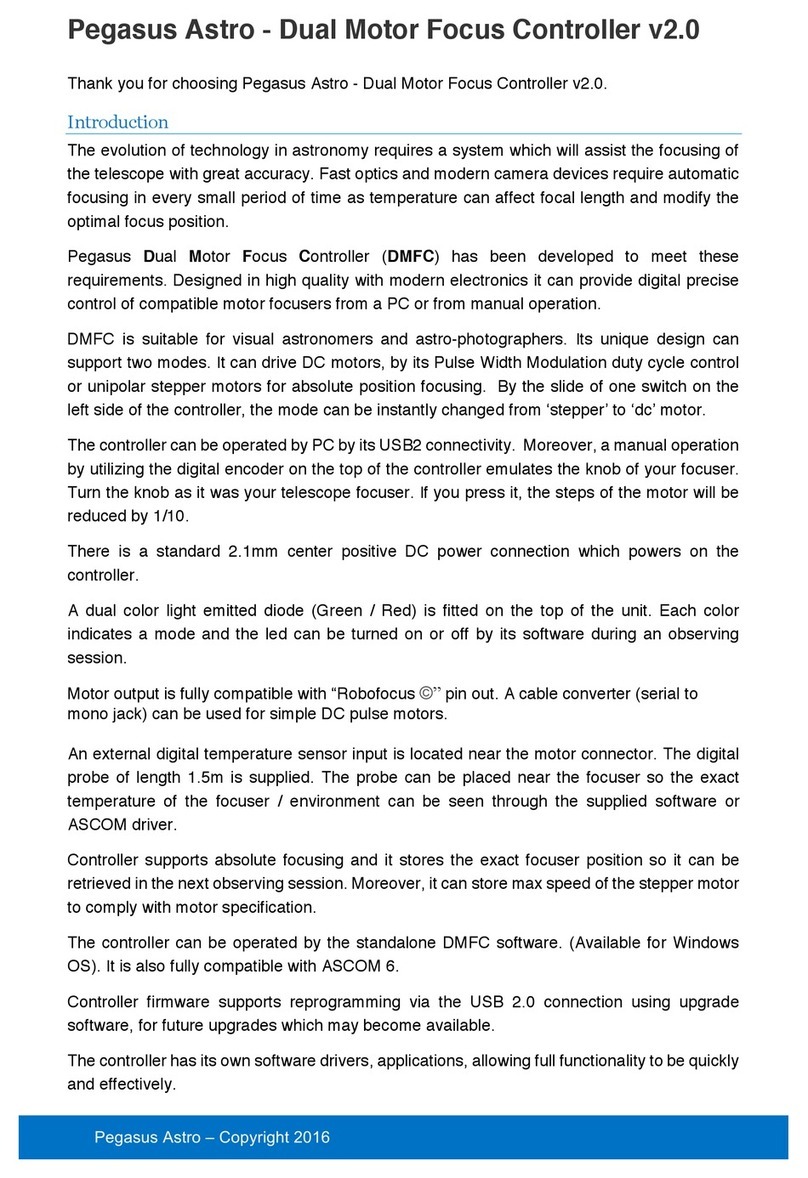
Pegasus Astro
Pegasus Astro Dual Motor Focus Controller manual

GM International
GM International D1048S instruction manual

Vivo Link
Vivo Link VLHDMICTL1-MME user manual

Timeguard
Timeguard ProgramaSTAT UFPT24 operating instructions
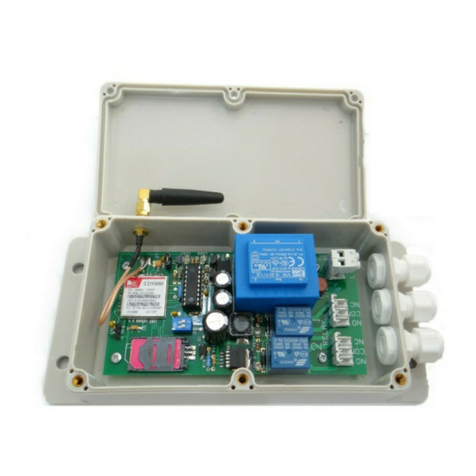
GSM Activate
GSM Activate SWV2G-RS2 manual

InnoMedia
InnoMedia ESBC 9378-4B Quick install guide
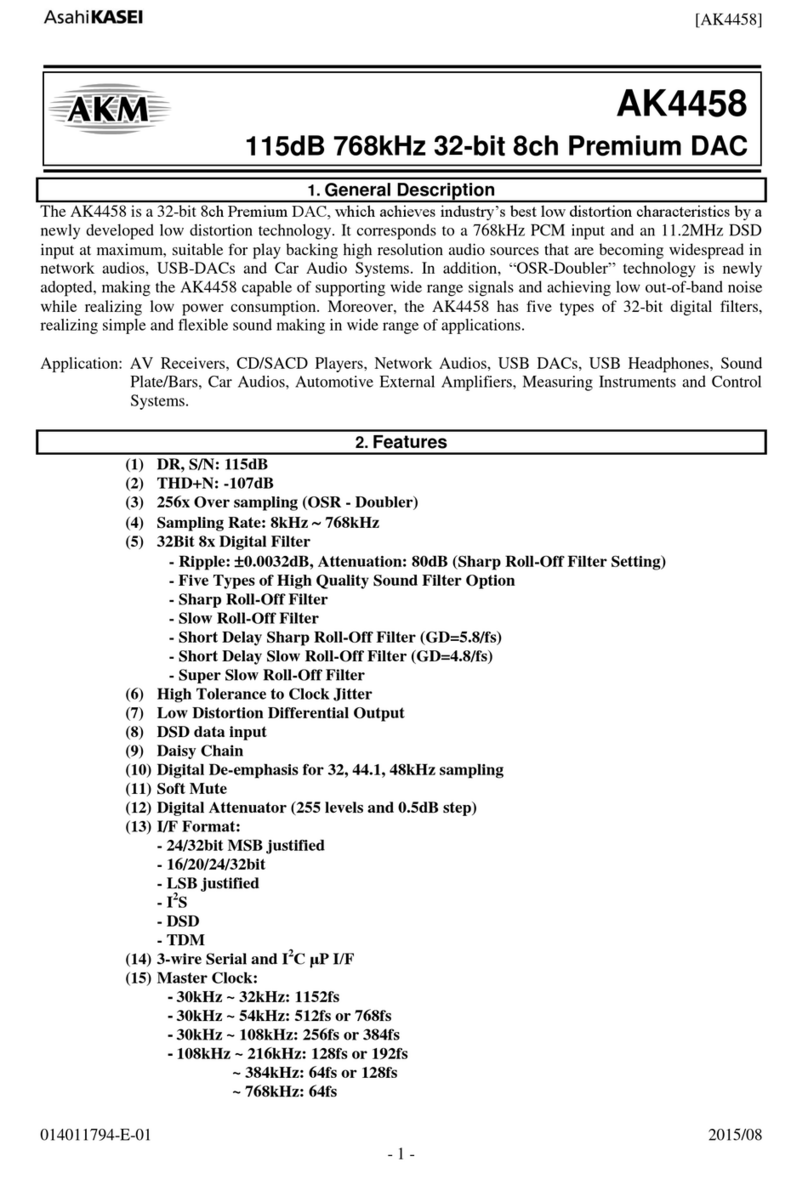
Asahi KASEI
Asahi KASEI AK4458 General description
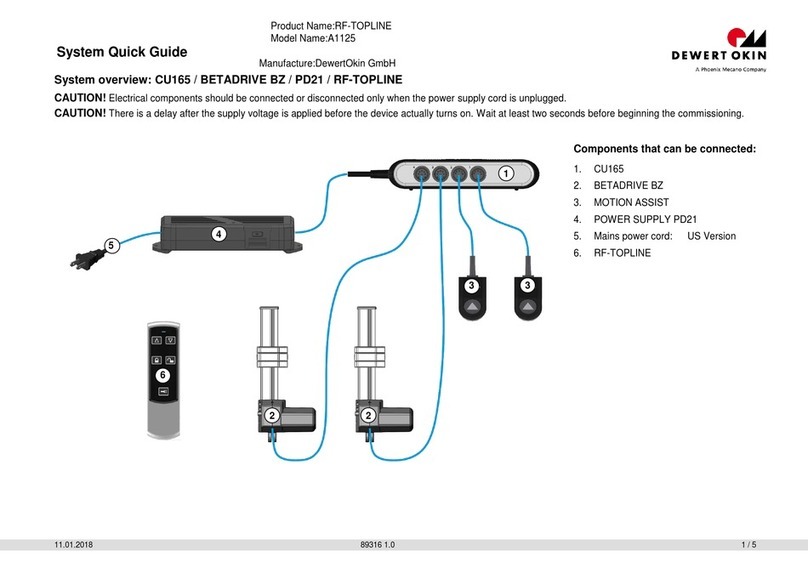
dewert okin
dewert okin A1125 quick guide
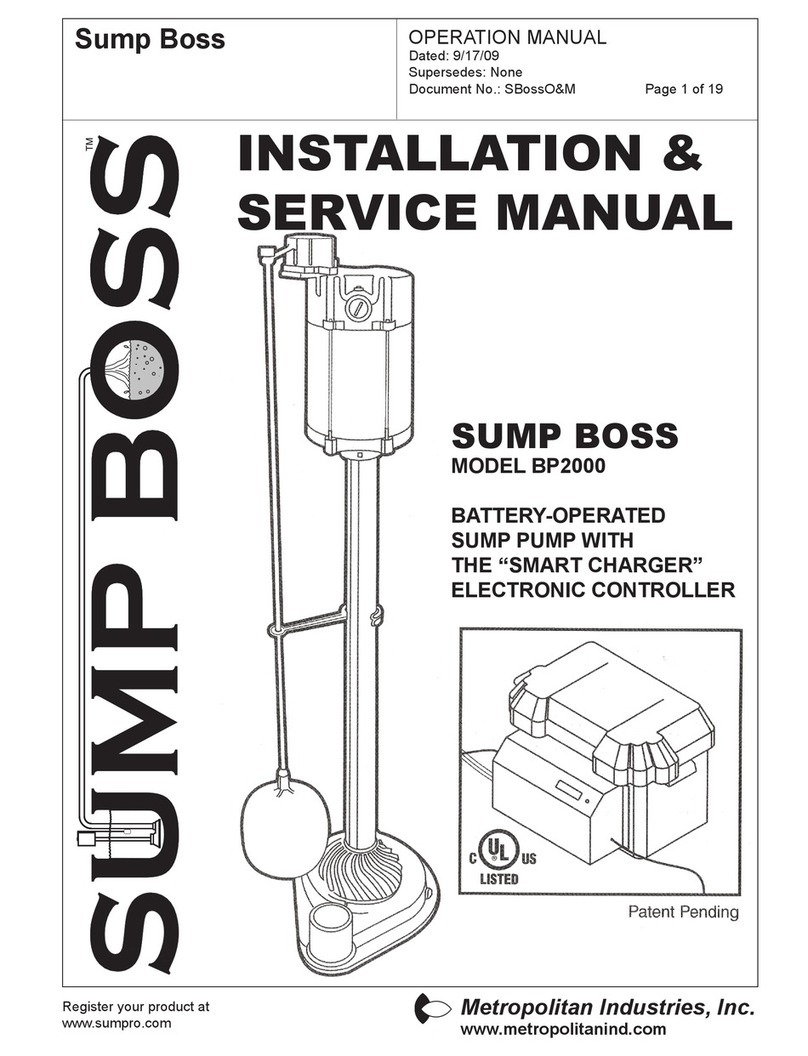
Metropolitan Industries
Metropolitan Industries Sump Boss BP2000 Installation & service manual
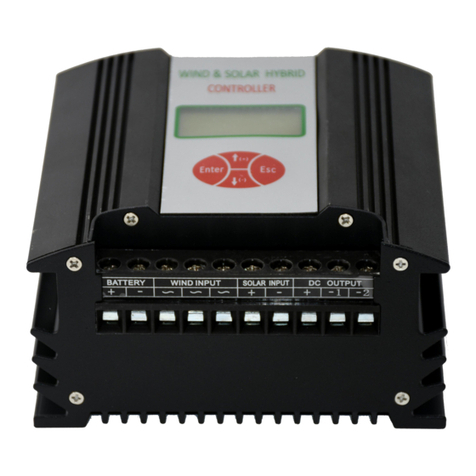
Winpower
Winpower SWS Series user manual

Elmo
Elmo Gold Lion 100 installation guide
